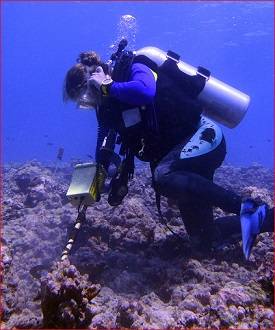Universities and Dive Teams use Underwater Metal Detectors

Hanna Ake, field researcher working for Professor Hunter Lenihan, uses the Pulse 8X detector to relocate specimens in Moorea, French Polynesia
The University of California at Santa Barbara is one of many universities that are employing underwater metal detectors in their research programs. Hunter Lenihan is a professor of applied marine ecology at UCSB’s Bren School of Environmental Science and Management. He studies the effects of restoration, ecotoxicology and ocean resource management on marine communities. One area of interest is in the impact of ecological and oceanographic processes on coral populations. This interest led the professor to become involved a long term coral reef research project in Moorea, French Polynesia with the goal of developing new techniques for reef management and restoration. As part of this work Lenihan and his team are isolating and cultivating disease resistant abalone in an effort to increase their numbers. To gather the needed data researchers must examine the health of many individual abalones over an extended period of time. To aid in locating and tracking the shellfish, researchers have affixed small metal tags to them. Using JW Fishers Pulse 8X underwater metal detector, divers doing the field work can quickly relocate the specimens they need to examine.
Another scientist using an underwater metal detector is Dr. Tasman Crowe with the Australian Center for International Agricultural Research. Crowe and his team are working on the Trochus Reseeding Project. Trochus is a conical shaped marine gastropod (snail) that inhabits shallow tropical reefs. Its shell is used to make buttons and jewelry. Global demand for this product is greater than 7,000 tons annually, valued at more than $60 million. To determine if the reseeding effort is successful, field workers study the snail’s movements through the habitat and periodically recapture individuals for examination. Crowe discusses the difficulty of attempting to track and locate these animals in a complex marine environment. “Trochus often move into and under live coral or coral ruble and cannot be found by visual searches. To solve the problem we affixed small aluminum tags to the trochus and use a Pulse 8X to local them. The methodology proved very effective as we were able to consistently recapture over 85% of a known number of juveniles.”
Scientists are not the only ones employing underwater metal detectors in their jobs. Many public safety dive teams are using these instruments to help find weapons used in the commission of crimes, as well as stolen property, that are disposed of in waterways. Criminals mistakenly believe if they throw a gun or knife into a lake, river or the ocean, it will be lost forever. Public safety divers routinely prove them wrong by recovering these items using an underwater detector.
Jamestown is a rural community in North Dakota located midway between Bismark, the state’s capital, and Fargo, the state’s largest city. Jamestown is the seat of Stutsman County. Although the county is small by some standards with a population of 21,000, and less than 4% of it is covered by water, Fire Chief Jim Reuther believes a metal detector is an important piece of equipment for his team to have. “When situations arise that require us to assist local law enforcement, we don’t want to be scrambling trying to find another agency that can provide a detector. We chose the Pulse 8X because it’s rugged, reliable and can be used both on land and underwater.”
Located in southeast Texas the city of Grand Prairie is much larger, both in area and population than Jamestown. A greater portion of the town of is also covered by water, 11%, with the Trinity River and Johnsons Creek running through town. As one would expect the Fire Department is also much larger with nine fire houses around the city. However, the department’s dive team acquired a Pulse 8X for exactly the same reasons as Jamestown FD. When the need arises for detector to locate some critical evidence or a murder weapon, the team would have one that can do the job.
A few of the other universities, institutions and dive teams using JW Fishers metal detectors are University of West Florida, Indiana University, University of Rhode Island, Texas A&M, Hong Kong University of Science and Technology, Woods Hole Oceanographic Institute, India’s National Institute of Oceanography, Skidaway Institute of Oceanography, Wheeling Police Dept. in W.Va., Wichita Falls Police Dept in Kan., Olmstead Sheriffs Dive Team in Minn., Missouri State Water Patrol, Japan’s National Police Agency, FBI, and state police dive teams across the U.S.
www.jwfishers.com













 December 2025
December 2025



